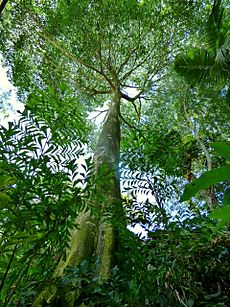Ficus insipida facts for kids
Quick facts for kids Ficus insipida |
|
|---|---|
 |
|
| Roots | |
| Conservation status | |
| Scientific classification | |
| Synonyms | |
The Ficus insipida is a common tropical tree. It belongs to the fig genus in the Moraceae family. This tree grows in habitats along rivers in forests. You can find it from Mexico all the way to northern South America.
Contents
About the Fig Tree's Name
The Ficus insipida tree was first described in 1806. A scientist named Carl Ludwig Willdenow gave it its scientific name. "Insipida" means "tasteless" in Latin, so the name literally means "tasteless fig." Willdenow thought its fruit had no taste. However, many people now know that when ripe, the figs of this tree are actually large and sweet!
Scientists sometimes group similar plants together. In the 1960s, one scientist thought that two other fig species, F. adhatodifolia and F. crassiuscula, were the same as F. insipida. He called them synonyms. But later, other experts disagreed.
In 1984, a fig expert named Cornelis Christiaan Berg found two main types, or subspecies, of Ficus insipida:
- Ficus insipida subsp. insipida: This type has mostly smooth twigs and leaves. It grows in Central America, the Caribbean, and parts of South America.
- Ficus insipida subsp. scabra: This type is much hairier. It is found in the Guianas and parts of northern Brazil.
The Ficus group is one of the largest plant groups, with about 750 different species. F. insipida is part of a smaller group called Pharmacosycea.
What the Fig Tree Looks Like
This tree can grow very tall, from 8 to 40 meters (about 26 to 130 feet). It often has large buttress roots that help support its trunk.
Ficus insipida is a pioneer species. This means it is one of the first trees to grow in new or disturbed areas, like secondary forests. It grows quickly and can become one of the largest trees in these forests in about 100 years.
Its leaves can be narrow or oval-shaped. They are usually 5 to 25 cm (2 to 10 inches) long and 2 to 11 cm (1 to 4 inches) wide.
Similar Fig Trees
In places like Costa Rica or Panama, you might confuse Ficus insipida with Ficus yoponensis. However, F. yoponensis has smaller leaves and fruit. It also only grows in old, untouched forests, while F. insipida can grow in newer forests too.
Another similar fig is Ficus crassivenosa. But this tree has different shaped leaves and doesn't usually grow near rivers like F. insipida does.
Where the Fig Tree Grows
The main type of Ficus insipida (subspecies insipida) grows from Mexico south through Central America to Colombia, Venezuela, Ecuador, Bolivia, Peru, and parts of the Amazon in Brazil. It also reaches north from Venezuela to Trinidad and Tobago and the Lesser Antilles islands.
The hairier type (subspecies scabra) is found from eastern Venezuela through the Guianas to northwestern Brazil.
In Mexico, it grows in many states, from the north to the south. In Costa Rica and Nicaragua, you can find it in lowlands along both the Atlantic and Pacific coasts. It also grows in the central valleys.
This tree is found in many parts of Bolivia, Ecuador, Colombia, and Brazil.
How the Fig Tree Spread Over Time
Long ago, during the last Ice Age, much of the Amazon rainforest was actually covered by grasslands. The forests were much smaller. After the Ice Age ended, the Amazon rainforest grew much larger.
Scientists have studied the genes of Ficus insipida trees. They found that trees in most of the Amazon area are very similar genetically. This suggests that these trees spread into the Amazon more recently, after the Ice Age. They quickly moved into new areas as the forest grew.
How Common is the Fig Tree?
The main type of Ficus insipida is quite common in Nicaragua and Panama. However, the scabra subspecies is considered rare in the Guianas.
Fig Tree Life and Habitat
Where the Fig Tree Lives
The Ficus insipida subspecies insipida usually lives in lowland forests, even near the coast. In Costa Rica, it grows from sea level up to about 1,100 meters (3,600 feet) high. In Nicaragua, it grows from 0 to 700 meters (0 to 2,300 feet), sometimes higher.
It can live in very wet, humid, or dry climates. But you will almost always find it growing along rivers. It often grows on slopes too.
The scabra subspecies prefers slightly different places. It is usually found on slopes in rainforests or mountain grasslands in the Guianas.
Life Cycle and Reproduction
Like many fig trees, F. insipida produces a lot of fruit. But each tree fruits at a different time than its neighbors. This means that no matter the season, there is always a fig tree somewhere producing fruit. This is great for wildlife that eats figs. It also helps the tiny wasps that pollinate the figs to find new trees, which helps the fig trees mix their genes. New leaves also grow at different times on different trees.
F. insipida is a monoecious species. This means each tree has both male and female flowers. The "figs" are actually special flower structures called syconia. Inside, they are covered with tiny male and female flowers.
The female flowers mature first. They have a special surface called a synstigma. This is where the tiny pollinating wasps walk and lay their eggs.
Tiny female wasps from the genus Tetrapus pollinate the flowers inside the figs. These wasps spend most of their lives inside the developing figs. The female wasps have wings, but their jaws are weak. The male wasps develop first. They are wingless but have strong jaws. They chew their way out of their individual fruit and then chew out the females. The males also make holes in the fig so the females can escape.
As the females leave, the male flowers inside the fig release their pollen. The pollen sticks to the female wasps. The female wasps then fly to a new fig tree to lay their eggs. Getting into a new fig is hard work! They have to squeeze through a small opening called an ostiole. Their wings often get torn off during this process.
Once inside, the females lay their eggs into the fig's ovules. While they are walking around and laying eggs, they also pollinate the other flowers. The seeds and the wasp larvae grow at about the same rate.
How the Fig Tree Spreads Its Seeds
Ficus insipida uses animals to spread its seeds. This is called zoochory. Bats, howler monkeys, spider monkeys, and capuchin monkeys eat the figs in the Guianas.
A large fish called Brycon guatemalensis in Costa Rica also helps spread the seeds. These fish eat the fallen leaves and figs of F. insipida. The fig seeds can pass through the fish's gut and still grow, though fewer of them will. This is helpful because fish can spread seeds along rivers, even upstream. This helps keep fig tree populations growing along rivers.
Howler monkeys in Panama love to eat the leaves and fruit of F. insipida. They spend a lot of time looking for these trees. Because the trees fruit at different times, the monkeys have special routes they follow to check which trees have ripe figs.
Uses of the Fig Tree
The milky sap, called latex, from Ficus insipida is sold in South America. It is used as a medicine to treat worms in the body. It is sometimes called 'doctor oje'. Studies have shown that it is generally safe when used correctly.
The latex can be cleaned to make a white powder called ficin. Ficin is a mix of different enzymes. It was first made in 1930. Scientists found that it could dissolve intestinal worms, which made people interested in it as a medicine.
Ficin has many uses in medicine and industry. It is used to clean materials for surgical stitches. It also helps prepare animal arteries for use in human transplants. Ficin is used to clean animal intestines for things like sausage casings. It can also be added to beer to make it resistant to freezing. Sometimes, it's even put in meat tenderizers.
According to a book from 1990, the fruit of Ficus insipida (which was once called Ficus anthelmintica) was used by some people in the northern Amazon of Brazil. They believed it could help improve memory.
Protecting the Fig Tree
As of 2021, the Ficus insipida tree has not been fully assessed for its conservation status by major groups like the IUCN Red List. However, in Costa Rica, this species grows in many protected areas. These include places like Estación Biológica La Selva, Carara National Park, Corcovado National Park, and Jairo Mora Sandoval Gandoca-Manzanillo Mixed Wildlife Refuge. This helps protect the tree and its habitat.
Images for kids
See also
 In Spanish: Amate para niños
In Spanish: Amate para niños







